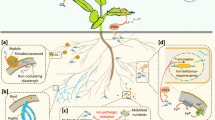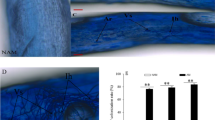Summary
Vesicular-arbuscular mycorrhizal fungi (VAM) are known to increase plant growth in saline soils. Previous studies, however, have not distinguished whether this growth response is due to enhanced P uptake or a direct mechanism of increased plant salt tolerance by VAM. In a glasshouse experiment onions (Allium cepa L.) were grown in sterilized, low-P sandy loam soil amended with 0, 0.8, 1.6 mmol P kg−1 soil with and without mycorrhizal inoculum. Pots were irrigated with saline waters having conductivities of 1.0, 2.8, 4.3, and 5.9 dS m−1. Onion colonized withGlomus deserticola (Trappe, Bloss, and Menge) increased growth from 394% to 100% over non-inoculated control plants when soil P was low (≤ 0.2 mmol kg−1 NaHCO3-extractable P) at soil saturation extract salinities from 1.1 dS m−1 to 8.8 dS m−1. When 0.8 and 1.6 mM P was added no dry weight differences due to VAM were observed, however, K and P concentrations were higher in VAM plants in saline treatments.Glomus fasciculatum (Gerdeman and Trappe) andGlomus mosseae (Nicol. and Gerd.) isolates increased growth of VAM tomato 44% to 193% in non-sterilized, saline soil (10 dS m−1 saturation extract) despite having little effect on growth in less saline conditions when soil P was low. Higher tomato water potentials, along with improved K nutrition by VAM in onion, indicate mechanisms other than increased P nutrition may be important for VAM plants growing under saline stress. These effects appear to be secondary to the effects of VAM on P uptake.
Similar content being viewed by others
References
Allen E B, Cunningham G L 1983 Effects of vesicular-arbuscular mycorrhizae onDistichlis spicata under three salinity levels. New Phytol. 93, 227–236.
Allen M F, Smith W K, Moore T S and Christensen M 1981 Comparative water relations and photosynthesis of mycorrhizal and non-mycorrhizalBouteloua gracilis H B K Lag ex. steud. New Phytol. 88, 683–693.
Azcon R, Barea J M and Hayman D S 1976 Utilization of rock phosphate in alkaline soils by plants inoculated with mycorrhizal fungi and phosphate solubilizing bacteria. Soil Biol. Biochem. 13, 19–22.
Barea J M and Azcon-Aguilar C 1981 Production of plant growth substances by the vesicular-arbuscular mycorrhizal fungusGlomus mosseae. Appl. Environ. Microbiol. 43, 810–813.
Bernstein L, Francois L E and Clark R A 1974 Interactive effects of salinity and fertility on yields of grains and vegetables. Agron. J. 66, 412–421.
Bethlenfalvay G J, Bayne H G and Pacovsky R 1983 Parasitic and mutualistic associations between a mycorrhizal fungus and soybean: the effect of phosphorus on host plantendophyte interactions. Physiol. Plant. 57, 543–548.
Champagnol F 1979 Relationships between phosphate nutrition of plants and salt toxicity. Phosphorus Agric. No. 76, 34–43.
Cooper K M 1975 Growth response to the formation of endotrophic mycorrhizas in Solanum, Leptospermum, and New Zealand ferns, pp 391–407.In Endomycorrhizas. Eds. F E Sanders, B Mosse and P B Tinker. Academic Press, London.
Gange T J and Page A L 1974 Rapid acid dissolution of plant tissue for cadmium determination by atomic absorption spectrophotometry. Atomic Absorption Newsletter 13, 131–134.
Hirrell M C and Gerdeman J W 1980 Improved growth of onion and bell pepper in saline soils by two vesicular-arbuscular mycorrhizal fungi. Soil Sci. Soc. Am. J. 44, 1413–1425.
Itai C, Richmond A and Vaadia Y 1968 The role of root cytokinin during water and salinity stress. Israel J. Bot. 17, 187–195.
Jarrell W M and Beverly R B 1981 The dilution effect in plant nutrition studies. Adv. Agron. 34, 197–224.
Maas E V and Hoffman G J 1977 Crop salt tolerance-current assessment. J. Irriga. Drain Div. ASCE 103: 115–134.
Mosse B 1973 Advances in the study of vesicular-arbuscular mycorrhizas. Annu. Rev. Phytopathol. 11, 171–196.
Ng P P, Cole A L J, Jameson P E and McWha J A 1982 Cytokinin production by ectomycorrhizal fungi. New Phytol. 91, 57–62.
Ojala J C, Jarrell W M, Menge J A and Johnson E L V 1983 Influence of mycorrhizal fungi on mineral nutrition and yield of onion in saline soil. Agron. J. 75, 255–259.
Phillips J M and Hayman D S 1970 Improved procedures for clearing roots and staining parasitic and vesicular-arbuscular mycorrhizal fungi for rapid assessment of infection. Trans. Br. Mycol. Soc. 55, 158–160.
Pond E C, Menge J A and Jarrell W M 1984 Improved growth of tomato in salinized soil by vesicular-arbuscular mycorrhizal fungi collected from saline soil. Mycologia 76, 74–84.
Powell C L 1975 Potassium uptake by endotrophic mycorrhizas, pp. 461–468.In Endomycorrhizas. Eds. F E Sanders, B Mosse and P B Tinker, Academic Press, London.
Author information
Authors and Affiliations
Rights and permissions
About this article
Cite this article
Poss, J.A., Pond, E., Menge, J.A. et al. Effect of salinity on mycorrhizal onion and tomato in soil with and without additional phosphate. Plant Soil 88, 307–319 (1985). https://doi.org/10.1007/BF02197488
Received:
Revised:
Issue Date:
DOI: https://doi.org/10.1007/BF02197488




